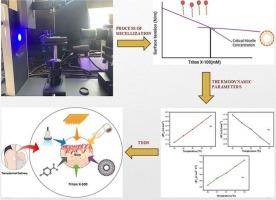探索双酚唑- triton X-100在二元溶剂体系中的表面能量学、润湿性和热力学见解
IF 5.2
2区 化学
Q2 CHEMISTRY, PHYSICAL
引用次数: 0
摘要
联苯唑是一种局部抗真菌药物,但由于其溶解度和渗透性低,其治疗效果受到限制。本研究探讨了联苯唑与非离子表面活性剂Triton X-100之间的物理化学相互作用,以提高联苯唑局部给药的溶解度和生物利用度。热力学研究使用三种不同浓度的联苯唑(1mg、5mg和10mg)、五种氢乙醇溶剂浓度(20% v/v、40% v/v、60% v/v、80% v/v和100% v/v)和五种温度(20°C至40°C)进行。测量了密度(ρ)、表面张力(σ)、接触角(θ)和表面自由能等参数。此外,临界胶束浓度(CMC)值由表面张力、吉布斯自由能(ΔG°)、标准焓变(ΔH°)和标准熵变(ΔS°)等关键热力学因素决定。ΔH°_(0)和ΔG°_(0)为负值,表明胶束是自发和放热的。采用接触角和表面自由能研究了体系的亲疏水性。结果表明,在特定的浓度和溶剂条件下,联苯唑-表面活性剂组合表现出更好的热力学稳定性,为优化外用药物配方提供了有价值的见解。本文章由计算机程序翻译,如有差异,请以英文原文为准。

Exploring surface energetics, wettability and thermodynamic insights of bifonazole–triton X-100 in binary solvent systems
Bifonazole is a topical antifungal agent, but its therapeutic effectiveness is limited due to low solubility and permeability. The study explores physicochemical interaction between bifonazole and the non-ionic surfactant Triton X-100 to enhance the solubility and bioavailability of topical delivery of bifonazole. The thermodynamic studies were conducted using three distinct concentrations of bifonazole (1 mg, 5 mg, and 10 mg), five hydro-ethanolic solvent concentrations (20 % v/v, 40 % v/v, 60 % v/v, 80 % v/v, and 100 % v/v), and five temperatures ranging from 20 °C to 40 °C. Various parameters, including density (ρ), surface tension (σ), contact angle (θ), and surface free energy, were evaluated. Additionally, critical micelle concentration (CMC) values were determined using the surface tension, along with key thermodynamic factors such as Gibbs free energy (ΔG°ₘ), standard enthalpy change (ΔH°ₘ), and standard entropy change (ΔS°ₘ). The ΔH°ₘ and ΔG°ₘ showed negative values, indicating spontaneous and exothermic micellization. The contact angle and surface free energy studies were employed to determine the hydrophobicity and hydrophilicity within the system. The results highlight specific concentrations and solvent conditions in which the bifonazole-surfactant combination exhibits improved thermodynamic stability, providing valuable insights for optimizing topical drug formulations.
求助全文
通过发布文献求助,成功后即可免费获取论文全文。
去求助
来源期刊

Journal of Molecular Liquids
化学-物理:原子、分子和化学物理
CiteScore
10.30
自引率
16.70%
发文量
2597
审稿时长
78 days
期刊介绍:
The journal includes papers in the following areas:
– Simple organic liquids and mixtures
– Ionic liquids
– Surfactant solutions (including micelles and vesicles) and liquid interfaces
– Colloidal solutions and nanoparticles
– Thermotropic and lyotropic liquid crystals
– Ferrofluids
– Water, aqueous solutions and other hydrogen-bonded liquids
– Lubricants, polymer solutions and melts
– Molten metals and salts
– Phase transitions and critical phenomena in liquids and confined fluids
– Self assembly in complex liquids.– Biomolecules in solution
The emphasis is on the molecular (or microscopic) understanding of particular liquids or liquid systems, especially concerning structure, dynamics and intermolecular forces. The experimental techniques used may include:
– Conventional spectroscopy (mid-IR and far-IR, Raman, NMR, etc.)
– Non-linear optics and time resolved spectroscopy (psec, fsec, asec, ISRS, etc.)
– Light scattering (Rayleigh, Brillouin, PCS, etc.)
– Dielectric relaxation
– X-ray and neutron scattering and diffraction.
Experimental studies, computer simulations (MD or MC) and analytical theory will be considered for publication; papers just reporting experimental results that do not contribute to the understanding of the fundamentals of molecular and ionic liquids will not be accepted. Only papers of a non-routine nature and advancing the field will be considered for publication.
 求助内容:
求助内容: 应助结果提醒方式:
应助结果提醒方式:


